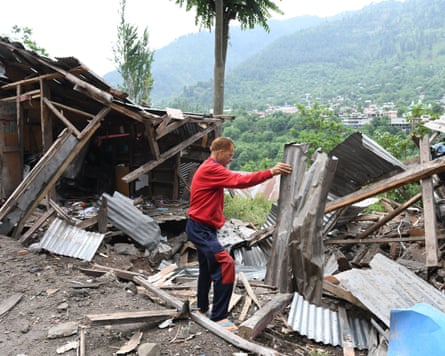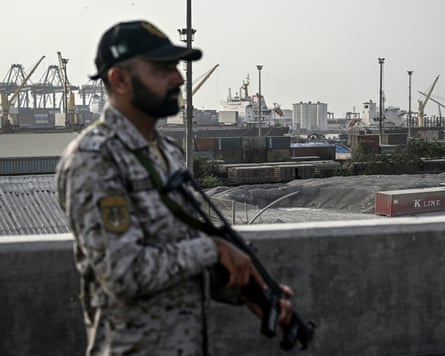India has accused Pakistan of launching an attack using up to 400 drones to target cities, military bases and places of worship across the north of the country on Thursday night, as the Pakistani military said it would “not de-escalate with India”.
India claimed to have intercepted hundreds of Pakistani drones, which it said came across the border into Indian-controlled Kashmir, as well as Rajasthan, Punjab and Gujarat. It said a first wave of drones came on Thursday evening and another wave hit close to dawn on Friday.
India said it had launched four drone strikes at Pakistan, directly targeting military defence infrastructure.
In a press conference on Friday, the Indian military alleged that Pakistan’s drone attacks on Thursday had targeted a gurdwara, a Sikh place of worship, injuring a civilian, and that the drones had also targeted Christian churches.
“The targeting of temples, gurdwaras, convents is a new low by Pakistan,” said India’s foreign secretary, Vikram Misri.
Pakistan’s information minister, Attaullah Tarar, denied the drone attacks, calling the Indian army statement “baseless and misleading”, and said Pakistan had not undertaken any “offensive actions” within Indian-controlled Kashmir or beyond Pakistan’s border.
However, a Pakistan security official told the Guardian that Thursday night’s drone strikes were just to “heat things up” before Pakistan launched a fully fledged retaliatory attack. “When we hit back, everyone will know,” they said.
Misri called Pakistan’s denial of the drone attacks “farcical” and “another example of its duplicity”.
The tit-for tat allegations were yet another alarming confrontation between India and Pakistan, two nuclear-armed countries, since India’s missile strikes on nine sites in Pakistan on Wednesday killed 31 people. Pakistan said it considered the attack an “act of war” and vowed to retaliate.
“We will not de-escalate – with the damages India did on our side, they should take a hit,” Pakistan’s military spokesperson, Ahmed Sharif Chaudhry, said at a media briefing. “So far we have been protecting ourselves but they will get an answer in our own timing.”
The Pakistani army gave new details of Wednesday’s strike in which it claimed Pakistan had deployed more than 100 planes to ward off the strikes by Indian planes that carried out the attacks from Indian airspace. It said the two sides had engaged in an hour-long aerial dogfight.

Pakistan claimed it used Chinese-made weapons and ground air defences to help bring down five Indian fighter jets. India has yet to respond to allegations that Pakistan shot down its planes, but debris from at least three fighter jets, including that of at least one elite French Rafale jet, was seen in Indian-controlled Kashmir and Punjab.
The worst-affected area from Thursday’s drone attacks was the city of Jammu, in India-administered Kashmir, which is close to the line of control (LoC), the heavily militarised border dividing the disputed region of Kashmir between India and Pakistan.
Despite decades of conflict in the region, people in the city said they had never witnessed such an aerial onslaught. They described a barrage of fiery projectiles streaking across the sky as air-raid sirens wailed and the city was plunged into an enforced blackout overnight.
Videos shared with the Guardian showed glowing orange dots piercing Jammu’s night sky before flashing and fading – probably drones intercepted by Indian air defence systems. Local officials confirmed debris from the projectiles had been recovered from several areas, including densely populated neighbourhoods in and around Jammu, but no casualties were reported.
Ajay Lakhotra, a 24-year-old student in Kanachak, a suburban area close to the Pakistan border, said: “Skirmishes and exchanges of gunfire are nothing new to us, but what happened on Thursday night was extraordinary. We saw fiery objects launching from the Pakistani side; the barrage was so intense it looked like fireworks lighting up the sky. Flames streaked everywhere. It was terrifying to witness.”
He said it had quietened down after midnight but restarted at 4am. “Most of us couldn’t sleep all night.”
Lethal aggression continued along the LoC as soldiers from both sides continued to fire across the border, killing and injuring civilians. With Pakistan’s threats to retaliate still looming, Indian-administered Kashmir and states across northern India remained on high alert.
The mounting aggressions and allegations have resulted in a growing information – and disinformation – war on both sides of the border.
India accused Pakistan of a flood of dangerous disinformation and “grossly exaggerated claims” across its media, including reports that dozens of Indian drones had been shot down over Pakistan, calling it a “gross misrepresentation of facts”.
“What should have been a moment of international reckoning against terror has instead been manipulated into a disinformation war, where truth is the first casualty,” India’s ministry of information and broadcasting said in a statement.

However, mainstream Indian media has also been flooded with misinformation and fake or unsubstantiated reports, including false claims of an attack on Karachi Port, reports of a military coup and the arrest of Pakistan’s army chief. Images of Turkish military personnel were broadcast as “captured Pakistani pilots”. Images of powerful bomb strikes on Gaza have been widely shared as showing India’s attack on Pakistan.
As part of its alleged crackdown on misinformation, India ordered the social media platform X to block more than 8,000 accounts, including those of Pakistani politicians, celebrities and media organisations, as well as Indian independent news organisations and Indian-Kashmiri journalists.
The move was confirmed by X in a statement, which said in many cases the Indian government had not provided legal justification for the blocks.
However, X said it had no choice but to comply and remove the 8,000 accounts or it would face “penalties including significant fines and imprisonment of the company’s local employees”.

 8 hours ago
7
8 hours ago
7













































